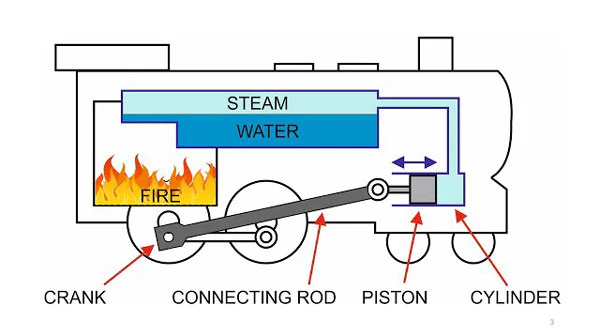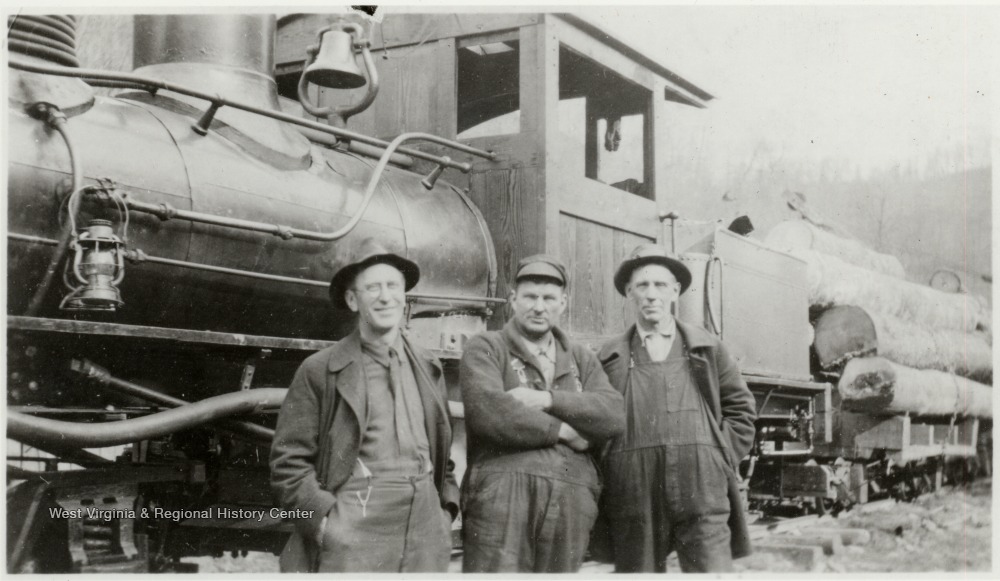How it Worked
The steam locomotive was a complex and innovative machine that
basically was an efficient method of turning coal into motion to
transport large loads that would be impossible to transport by any
other means. It did this by burning coal to boil water, using that
steam to create motion then transferring the back-and-forward motion
from the pistons to rotational movement of the wheels. These
machines ran on tracks, and in this section we will also outline the
challenges related to these tracks.
The boiler was the part of the steam engine that created the steam
to power the rest of the system, and is vital to the function of the
steam locomotive. The “fireman” would shovel coal into the firebox,
which had a grate underneath to let air through. The heat generated
by the burning coal was then used to boil the water. Which could be
used to power the rest of the system.
The steam power from the boiler was transformed into motion in the
pistons. The steam was trapped to create high pressure, which in
turn pushed up the piston. When the piston got to the end of that
stroke, that steam was released and the valve would switch to
applying the steam to the other side of the piston, pushing it back
the other way. The steam engines in locomotives didn’t use condensing
steam, as that would limit the speed of the engine, and a full
condenser would add weight as well. Another key part of the engine
was the flywheel, which maintained the motion of the pistons. The
flywheel was directly connected to the pistons, and would pick up
speed as the pistons pushed, and when there were gaps, would
continue to provide smooth motion for the locomotive. This was
especially important in early designs that only had a single piston.
However, later engines simply relied on the main wheels themselves
to smooth motion, without the need for an external flywheel.
 Now we get to how this back-and-forth motion made by the pistons
gets transformed into the rotational movement of the wheels which
drives the train forward. Attached to the piston, inside the
cylinder, was a hinged rod. The other end of this rod was attached
to a pin which was offset from the centre of rotation of the wheel,
so that as the piston was driven forward by the steam, it would push
around on the top of the wheel, and would reach the front by the end
of its push. Then, the piston would be driven back in the other
direction, and would now pull around on the other side of the wheel,
continuing its rotation. This pattern would repeat as the piston
went back and forth over and over. This system, however, only
powered the wheel nearest to the engine. There was another rod
connected to the same pin that was mentioned, which was connected to
another pin in the same place on all of the other wheels, allowing
the engine to apply power evenly to all of the wheels.
Now we get to how this back-and-forth motion made by the pistons
gets transformed into the rotational movement of the wheels which
drives the train forward. Attached to the piston, inside the
cylinder, was a hinged rod. The other end of this rod was attached
to a pin which was offset from the centre of rotation of the wheel,
so that as the piston was driven forward by the steam, it would push
around on the top of the wheel, and would reach the front by the end
of its push. Then, the piston would be driven back in the other
direction, and would now pull around on the other side of the wheel,
continuing its rotation. This pattern would repeat as the piston
went back and forth over and over. This system, however, only
powered the wheel nearest to the engine. There was another rod
connected to the same pin that was mentioned, which was connected to
another pin in the same place on all of the other wheels, allowing
the engine to apply power evenly to all of the wheels.
Another vital part of the function of the steam locomotive in the
Industrial Revolution was manpower. There were various roles to be
played in the operation and control of a full steam locomotive,
including the driver/engineer, the fireman/stoker, and the
brakeman/guard. The engineer was responsible for the control of the
engine: operating the speed and direction with the steam regulators
and gears, and monitoring the pressure gauges and water levels, and
watching the track ahead for hazards. The fireman was responsible
for shovelling coal into the firebox to fuel the boiler, managing
the fire to maintain a regular and even heat, and adjusting
temperatures based on the engineer’s instructions. The guard was
responsible for stopping the train with various levers positioned
along the length of the train, and also for notifying the engineer
about track conditions such as obstacles and things and assisting
with the coupling and uncoupling of the carriages.
 Originally, steam locomotives were used on the cast-iron rails used
by horse drawn carriages in years before. But it was soon found that
these rails were impractical, as they were too brittle for the heavy
loads that were steam trains, and frequently cracked and broke under
the weight. In 1820, John Birkinshaw invented rolled wrought iron
rails which were significantly stronger than their cast-iron
predecessors and were strong enough to bear the weight of the heavy
steam locomotives. This was a major development that made the
technology much more practical.
Originally, steam locomotives were used on the cast-iron rails used
by horse drawn carriages in years before. But it was soon found that
these rails were impractical, as they were too brittle for the heavy
loads that were steam trains, and frequently cracked and broke under
the weight. In 1820, John Birkinshaw invented rolled wrought iron
rails which were significantly stronger than their cast-iron
predecessors and were strong enough to bear the weight of the heavy
steam locomotives. This was a major development that made the
technology much more practical.
Steam locomotives were complex and innovative machines that utilised
steam pressure from a coal heated boiler to produce motion which was
transmitted through a crank shaft into wheels to run on wrought iron
tracks to carry heavy loads long distances. They had a crew of
people to operate them and were a major development from the
Industrial Revolution.
